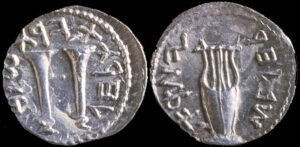
Bar Kokhba coin depicting trumpet and lyre. By http://en.wikipedia.org/wiki/User:IsraelXKV8RTallenna tiedosto – Wikimedia Commons – http://upload.wikimedia.org/wikipedia/en/9/9a/Bar_Kokhba_Coin.jpg, CC BY-SA 3.0, https://commons.wikimedia.org/w/index.php?curid=4081893
What archaeologists find is important. But what they don’t find can be just as important—such as their failure to find coins anywhere in the world before the end of the 7th century B.C. In the Holy Land, coins are not found until about 100 years later.
This total absence of coins—despite extensive excavations—is an important datum in itself. It means that Biblical references to specific coins during the First Temple Period (c. 960 B.C.–586 B.C.) are anachronistic. The Biblical historian writing at a later time, when coins were in use, assumed—incorrectly—that they were in use at an earlier period.
There are several examples of this kind of anachronism in the Bible. The author of the first book of Chronicles (writing during the Persian Period (539–333 B.C., the beginning of the Second Temple period) anachronistically assumed that coins were in use in the earlier period he was writing about; the author tells us of contributions of darics to assist in building Solomon’s Temple (see 1 Chronicles 29-7).
Before the introduction of coinage, commerce and exchange were carried on in the Holy Land by weighing precious metals—gold and silver—with weights and scales. This system was cumbersome, and the accuracy of the weights was questionable.
Read the rest of The Holy Land in Coins in the online Biblical Archaeology Society Library.